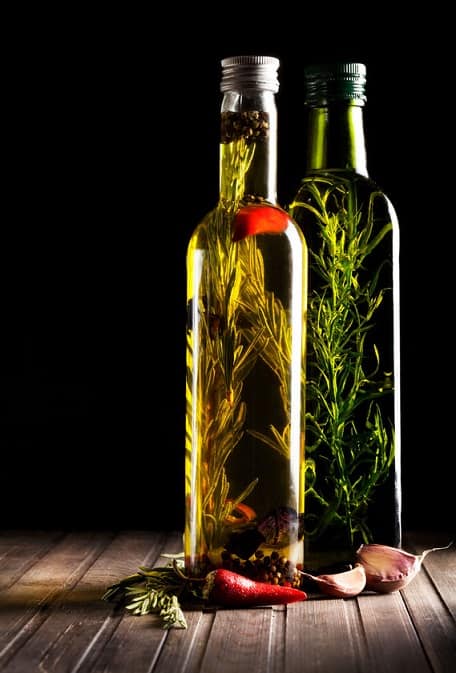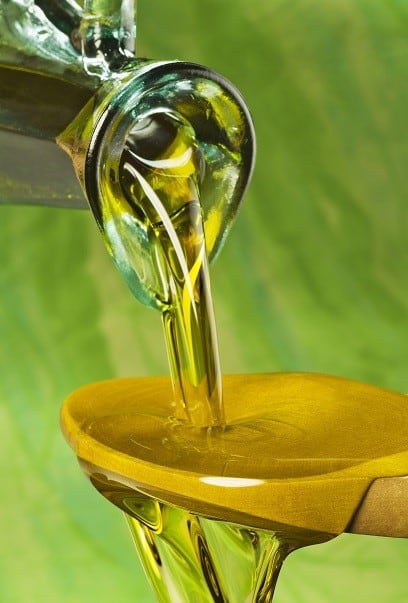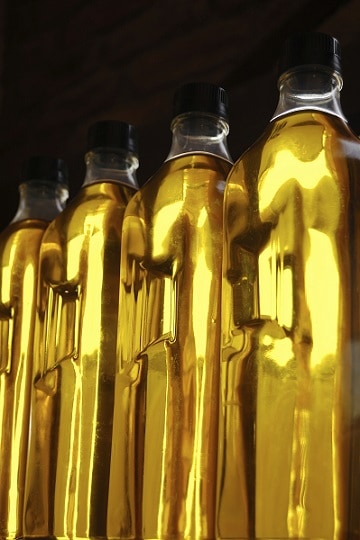 Olive oil is a fantastic food for acne. It isn’t just its nutrients like vitamin E, or its antioxidants like oleocanthal. It’s also the strategical elements, that it can replace inflammatory cooking oils like soybean oil or corn oil.
Olive oil is a fantastic food for acne. It isn’t just its nutrients like vitamin E, or its antioxidants like oleocanthal. It’s also the strategical elements, that it can replace inflammatory cooking oils like soybean oil or corn oil.
But what if I told you that fraud is rife in the market? Some have estimated that 80% of olive oil bottles on US store shelves are not the extra virgin they claim. It’s possible that the olive oil in your cupboard is fake right now.
Sometimes it seems like everything is fake. Fake olive oil bottle, fake honey, fake tree oil, fake cashier and even a fake supermarket.
However, there’s isn’t much fraud in the coffee industry, because coffee connoisseurs are so obsessed with fine tastes and shade grown beans and all that. Like honey, olive oil has a particular problem.
In fact, it’s estimated to be the single most adulterated food item in the European Union. If you think that you’ve eliminated soybean oil from your diet, then you could be very wrong…
Ancient times
Olive oil fraud is essentially the olive oil industry’s evil twin. As the prophecy foretold, one cannot exist without the other. Fakeness and deceit was born at the very second the first drop of oil was squeezed out of a fruit and stored in a handcrafted rock jar.
For example, the earliest writing about olive oil that archaeologists have discovered came from cuneiform tablets in the Syrian city of Ebla, dating back to the 24th century BC.
This text already mentions inspectors who toured olive oil farms on the king’s orders, looking for fraudulent practises. Translated, it references the “olive oil surveilling team at Nazar”.
In fact, it probably went back further. If Mediterranean cavemen were aware of olive oil, then a representative of a neighbouring tribe could have easily been dispatched to trade a fake clay jar of it for a batch of spears.
By the Roman era, Galen warned of dodgy traders who cut their olive oil with lard. A famous Roman merchant caled Apicius had a cookbook where he recommended mixing cheap, unpleasant oil from Spain with herbs and roots to recreate the prized olive oil of Istria.
The Romans were obsessed with olive oil, seeing its position on a dining table as proof that the Italians had conquered Europe. The oil was carried in jars called Amphoras, and legally, these had to be stamped with insignias declaring the farmer and town that it came from, and even the imperial inspectors who checked the oil when it arrived. They were obsessed with stopping fraud, more so than we are today. These jars were discovered stashed away at Monte Testaccio in Italy.
The current situation
 Which brings us to the modern era. What has changed? In a nutshell, nothing. Olive oil is still popular, and therefore, olive oil fraud is still popular.
Which brings us to the modern era. What has changed? In a nutshell, nothing. Olive oil is still popular, and therefore, olive oil fraud is still popular.
You have three categories of dodginess. Level 1 is a mostly extra virgin olive oil which has been diluted with non-virgin stuff, to push their profits just over the line into a viable business. Level 2 is poor quality olive oil diluted with other vegetable oils like soybean or canola.
Level 3 is where the only involvement of olive oil is the letters on the bottle. Instead, it is other oils coloured with beta-carotene or green-tinged chlorophyll and flavoured with aroma.
Profit wise, fake olive oil is supposedly the food equivalent of cocaine trafficking. Look around your favourite grocery store; there are almost certainly dozens of impure bottles in it.
The EU has several official requirements for extra virgin olive oil. It must be cold or expeller pressed, and it must meet 32 chemical requirements, including 0.8% acidity, since acidity is an accurate measure of decomposition. Every month, they bash the door down on suppliers who don’t meet these standards.
One interesting illustration is the feared pathogen Xylella Fastidiosa. This pathogen is an invisible microorganism which is reaching epidemic porporitons in the olive groves of Europe, and a constant feature in news reports.
The bacteria withers the roots of olive trees, causing them to suddenly die, as their nutrient source dries up. As of April 2020, Italy’s olive yield has fallen by 60% since the first discovery in 2013. The total economic cost is predicted to be €20 billion.
Yet despite this, since July 2017, the price has fallen by 40%. Like with tea tree oil, there is a loophole in the universe: Italy sells 3 times more extra virgin olive oil than it produces.
It is clear that many farmers have succumbed to the dark side of adulteration, in an epic moment of choice, to keep their businesses afloat. Noble farmers who stick to traditional methods cannot compete.
Many bottles are “made in Italy” only in the loosest sense. They are actually cobbled together from Spanish, Tunisian or Moroccan farms and sent to Italy for assembly into bottles.
Disguising fake oils is easy. To the average guy or girl whose dad, granddad and great granddad wasn’t toiling away in the oil mill, you can add just 30% extra virgin olive oil to canola oil and have the taste be undetectable. It won’t be tip top, but it’ll pass muster.
Detecting these oils in a laboratory is easy, but those tests often never happen, because it isn’t possible to inspect all 350,000 tons entering the US each year. FDA officials have confessed that their resources are too limited to police the industry.
Police are in a tricky situation; if they swarm a dock, raid a ship but don’t find a single impure bottle, it will blow up in their face. The publicity won’t be good.
The supply chains are also so long and twisty that’s it hard to identify who’s guilty. For example, in 2006, federal marshals raided warehouses in New Jersey. They found 41,000 liters of adulterated olive oil which were destined for Krinos Foods, part of the North American Olive Oil Association.
Krion Foods claimed to be innocent, blaming their supplier, DMK Global Marketing, who in turn blamed the original Italian bottler. Eventually, no charges were brought against Krinos Foods or anybody. One party was guilty, though, and that party lived to defraud another day.
Admittedly, it is pretty tempting to grab some orange juice, mix it with corn oil and write “oliv oiyul” on the label in crayon, but things are getting totally out of hand.
Even the mafia is getting their hands dirty!
 It seems that olive oil is a mafioso tradition as old as a kiss on the cheek or depressing violin music. The godfather of olive oil was the good Guiseppe “Joe” Porfaci, born 1897. After a conviction in Italy for stealing, he moved to Chicago aged 24 and tried to become a baker. This business collapsed, so he turned to the olive oil trade.
It seems that olive oil is a mafioso tradition as old as a kiss on the cheek or depressing violin music. The godfather of olive oil was the good Guiseppe “Joe” Porfaci, born 1897. After a conviction in Italy for stealing, he moved to Chicago aged 24 and tried to become a baker. This business collapsed, so he turned to the olive oil trade.
Before long, he was the officially recognised head of the Profaci crime family, sitting at the table of the National Crime Syndicate alongside 4 other family heads, organised by Charles “lucky” Luciano. He made millions with gambling, protection rackets, and prostitution, but in the midst of it, he never abandoned his olive oil routes. The “Mamma Mia Importing Company” continued to make a killing, particularly during World War 2, earning him the glorious title of the Olive Oil King.
Was Porfaci’s olive oil adulterated? We don’t know – it would be odd if despite being a mobster, his olive oil was actually the purest, freshest on the market.
Regardless, these days olive oil is the mafia’s playground. For some Mafia families, it’s just as important as cocaine or heroin. It’s said that the mafia has infiltrated the entire food chain, from farm to factory.
It isn’t what springs to mind when you first think mafia, but in 2017, Italian police arrested 11 associates of the Ndrangheta crime family in southern Calabria. The gang had exported 10 tonnes of “extra virgin” olive oil to the US, which was actually olive pomace oil. This cast off is taken from the olive fruit after the first press where 92-94% of the fresh oil is removed. Harsh chemicals like hexane are needed to remove it, and the result is grotty and bitter, with no decent nutrients.
As a more concise term: it’s the leftovers. The charges laid at their feet were mafia association and fraud.
Just days earlier, the police had cracked down on 33 members of the Piromalli family. The charges were grave: murder, theft, money laundering, and, er, olive oil fraud.
This vicious mob used the exact same pomace oil scheme as the Ndrangheta. The Pimorelli supposedly has a tight grip on agriculture in the Gioia Tauro municipality. Their contacts in the government are numerous (or were), and by pulling the strings like a puppetmaster, they can make agricultural officials look the other way.
They also conquered distribution chains in the northern city of Milan, simply “taking over” legitimate businesses. The Pimorelli’s fraudulent products were no small beer, ending up in New York City, Chigaco and Boston alike.
That bottle on your supermarket shelf may be the offspring of killing and stealing. By tracking down a decent olive oil brand, you are making the mafia one cent poorer.
The store shelf situation
 It’s one thing for Interpol to raid a warehouse in a mafia-controlled Italian island – what’s happening in grocery stores near you?
It’s one thing for Interpol to raid a warehouse in a mafia-controlled Italian island – what’s happening in grocery stores near you?
The classic figure floating around is that 80% is fraudulent, either to a minor or massive degree, which came from a great 60 minutes exposé in 2016.
In 2017, Australia’s Choice magazine gathered 24 imported and 26 local olive oil brands, and had them tested by IOC-accredited sensory panel. They used the ultimate taste detectors, the human equivalents of sniffer dogs, people trained to detect extra virgin olive oil at first sip. The care these people take is immense; they have separate cubicles to prevent cheating, and blue glasses to disguise the oil’s colour.
Only 73% of the oils were extra virgin, while only 63% of imports met the taste and sensuary requirements.
However, that’s way better than Spain. In 2018, they almost fell below the feared 50% mark. Just 21 out of 41 olive oils gathered from supermarkets passed the IOC-accredited olive oil sensory test.
Returning to the kangaroo kingdom, 3 studies from 2008-2010 tested 265 olive oils, with 127 from Australian producers and 138 from import. In 2008, 81% of imported oils failed a proper laboratory test for extra virgin. This fell to 66% in 2009 before rocketing upwards to 91% in 2010. Just 9% of imported olive oils were equivalent to the raw, nutritious fat of an olive fruit.
Not even Germany is immune. 266 oils were tested in 2015 and some were deemed so bad that they were inedible “lampante” class. You guessed it; this is olive oil so nutritionless that’s it only fit for lighting lamps.
These investigators patrolled the streets of Stuttgart, taking out olive oil crime wherever they saw it (well, maybe in their own minds). For example, 1 fake batch was a tiny bottle served for seasoning in a pizzeria. The restaurant owner wasn’t guilty, as he had purchased the oil from a reliable olive oil distributor. 12 online bottles were examined, and 4 seemed to be missing the extra virgin characteristics. They also discovered that most flavoured olive oils were obviously rancid, AKA swimming with free radicals.
Overall, 32.3% were “objectionable”, worse than the previous year, at 25%.
As for the US? In 2015, the National Consumer League found that 6 out of 11 olive oil bottles taken from big US retailers were not extra virgin, including from Giant, Safeway and Whole Foods. They were tested in an accredited Australian lab, using both chemical and sensory testing. In the stronghold of Italy, it’s estimated that 50% of olive oils on supermarket shelves are fake.
How do they adulterate them?
Originally, olive oil barons just cobbled together a bit of soybean oil and corn oil and laughed all the way to their private island. However, laboratories caught on in no time; the nutritional profiles were too different.
These days, all the rage is the undetectable hazelnut oil. For example, olive oil’s fatty acid profile is approximately 70-85% oleic acid, 10% palmitic acid, and 10% linoleic acid. Hazelnut oil is very similar, at 80-85%, 5% and 11%. It’s very different to soybean oil, with only 26% oleic acid, 11% palmitic acid, and 51% linoleic.
Consequently, in this study, researchers couldn’t detect oils which they themselves had spiked with 10% hazelnut oil. Heavy refinement also destroys antioxidants unique to the hazelnut plant which would be more easily detectable.
Elsewhere, chlorophyll can be chemically altered with copper, to produce a permanent green pigment. Companies also add beta-carotene, the orange coloured antioxidant found in sweet potatoes and carrots. Together, these ingredients restore the naturally vibrant colours that were lost when soybean oil was added.
Then there’s deodorisation, a new trend, a chemical refinement which removes subtle plant flavours and smells. This is great for scammers because it disguises their precious hazelnut or soybean oils. “Soft deodorisation” only destroys small amounts of phenolic antioxidants and pyropheophytins, chlorophyll pigment by-products, two of the main substances a healthy olive oil should contain. Scientists have found that after adding soft-deodorised olive oil to 50% extra virgin olive oil, you can’t detect the adulteration.
The story of Domenico Ribatti
If you want a clear picture of what some dodgy companies are up to, then there’s one epic tale which rolls all the cliches of olive oil fraud into one.
Domenico Ribatti was the owner of Riolio, and by the 1980s, he was arguably the world king of olive oil, selling the most bottles of anyone. By 1994, he was expelled from the Italian Oil Industry Association (Assitol) and serving a 13 month prison sentence.
His masterplan involved a rusty tanker docking in the Turkish port of Ordu. Named Mazal II, it would collect 2000 tons of oil, before sailing into the sunset and arriving at the southern Italian port of Bugletta several weeks later. The ships contents were listed as “Greek olive oil”, and passed through customs as smoothly as butter, before being piped into tanker lorries. After a short drive, the mysterious liquid ended up in Riolio’s refineries, before finally fulfilling its destiny as Riolio olive oil on store shelves.
The contents of that rusty tanker were hazelnut oil grown in Turkey, and sunflower oil grown in Argentina.
For years, Riolio sold fake olive oil to Italian customers by the gallon. Sometimes, it would be blended with real olive oil.
With the gap between the cheapness of hazelnut and sunflower oil, and the prestigious reputation of olive, Ribetti became a very rich man. He splashed cash around on department stores and real estate. He was so powerful that allegedly, he secured a special favour for an associate’s nephew to be accepted into a military school.
By early 1992 though, he was under investigation by military police working for the Italian finance ministry. For 2 years, they patiently gathered evidence. Listening in on phone calls, they heard the rustle of bribe money being offered to corrupt officials by Riolio executives. One policeman posed as a humble waiter, with a recording device hidden in his tie, during a lunch hosted by Ribatti at the Grand Hotel in Rome.
The European Union’s anti-fraud office soon got in on the action too. Policeman followed a trail of corruption leading to Swiss bank accounts and Caribbean shell companies, all engineered for olive oil fraud. Eventually, they stumbled in on shipments of hazelnut oil in Rotterdam waiting to be shipped to Riolio, plus other crooked companies.
Finally, in March 1993, Ribetti and 3 accomplices were arrested on charges of contrabrand, including his chief chemist. He was also slapped with a charge of defrauding the European Union, as it transpired that he had received 12 million euros in EU olive oil subsidies.
Initially, Ribetti insisted that he was a victim too, that he was sold hazelnut oil by olive oil companies lower down the food chain. But his house of cards collapsed when the Swiss financier controlling those companies revealed that the owner was none other than Ribetti himself.
It was proven that he bribed two officials, one with cash, and one with, what else, but cartons of olive oil. Ultimately, he was given 13 months in jail.
The story didn’t end there, as police realised that they could track the rusty tankers to other crooked dealers in shores as distant as Mexico. The EU also cancelled its olive oil subsidy program in embarrassment, but bounced back by setting up a crack olive oil task force in 1998.
The verdict
Olive oil fraud is still going strong, and there’s a very real chance that you might buy a fake bottle.
So what should an acne patient do? Obviously, your bottle should be extra virgin olive oil. It should have authenticity stamps like California’s COOC Certified Extra Virgin, Italy’s DOP, or the EU’s Protected Designation of Origin (PDO).
Beyond that though, there is no substitute for doing your own research on the company in question. With the internet, things are way easier. You only have to search a brand name and stories about questionable activity will pop up, or of course, noble and wholesome activity.
That’s my main recommendation. The certificates and taste indicators are all well and good. They are useful, but this is leaping two steps ahead and getting to the heart of the matter.
Watch out though, because one classic detection method doesn’t always work. It’s said that if you store olive oil in the fridge, it will “gel”, turn semi solid, and that adulterated oils will not.
The truth? The gelling happens because olive oil has a monounsaturated molecular structure, inbetween saturated (solid butter) and polysunsatrated fats (liquid soybean oil). However, if olive oil is adulterated with another monounsaturated fat, like the common hazelnut oil, it won’t make any difference. It would work for soybean oil, but it all depends on the fat.
Alongside honey, olive oil is the acne-clearing food where you need to be most vigilant.
PS: remember that olive oil is great for acne as a food, but not as a topical treatment.
Thanks for reading!